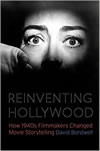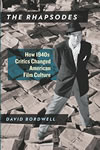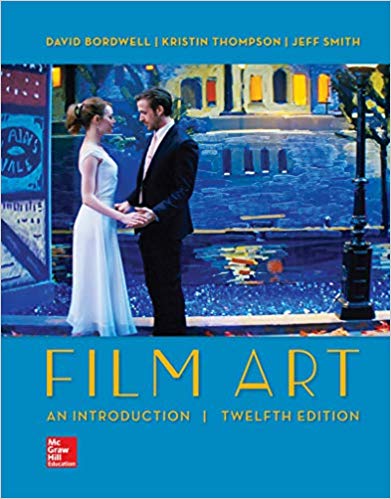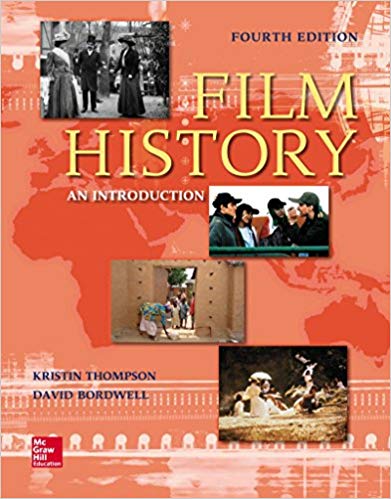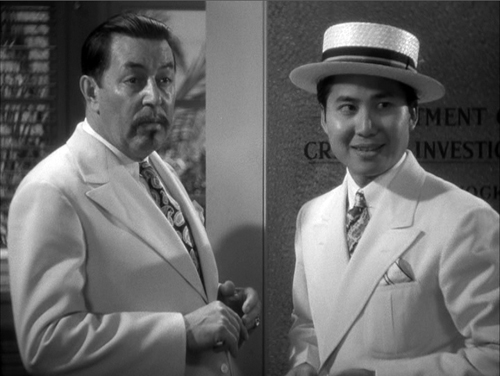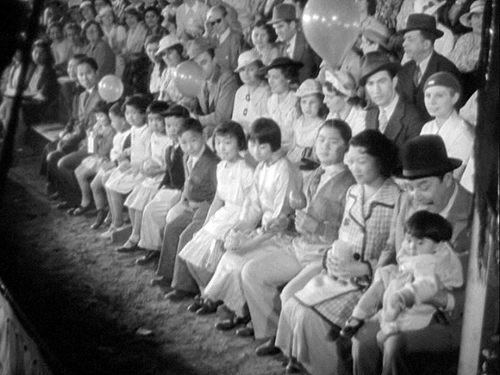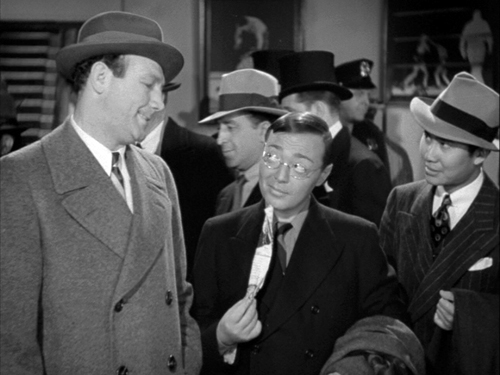Archive for the 'Film industry' Category
A many-splendored thing 3: Filmart and filmfans

The annual Hong Kong Filmart is a trade show for all aspects of film/TV production and distribution. As in past years it commands several floors of the Convention and Exposition Center, shown in yesterday’s entry. There are many screenings (thinly attended) but the main business is dealing. Representatives from Europe and Asia meet and greet in their display spaces, or more often in restaurants and hotel rooms. Here are some snapshots from the floor of the market, which I managed to visit on Wednesday.


The cheerful Park Jiyin gave me some publications and DVDs from the Korean Film Council. She had read Film Art in her university courses!

Sanrio’s display areas were pretty nifty.

On the Filmart floor I again ran into King Wei-chu, brandishing yet another of his poster treasures while we talked with Ip File, a publicity executive for Celestial Pictures (current owners of the Shaw film library). Mr. Ip also worked as an assistant director to Chor Yuen, one of the best Hong Kong directors of the 1950s-1970s.

After cruising Filmart I caught the trade screening of Twins Mission, a goofy but likeable Hong Kong film by martial arts choreographer Kong Tao-hoi. Twins, in case you don’t know, are, or is, a pair of girl pop singers who have made some films before this, notably The Twins Effect (2003). In this entry, Twins are now trapeze artists, and they encounter a squad of kung-fu killers, all themselves either male or female twins. It’s gradually revealed that our Twins were trained in the martial arts along with many other twins…by kung-fu masters who are twins. Confused yet? Given that our Twins don’t resemble one another, the premise seems a sendup of the very idea of twins and, er, Twins.
The agreeable fight sequences are enhanced by digital effects; my favorite passage includes a moment when a spinning blade trims one girl’s eyelashes. There’s a mawkish subplot about a little kid with cancer, but the presence of Sammo Hung and Yuen Wah, who literally plays his own evil twin, more than makes up for it.
A sequel seems already to be shot. This movie, released about a month ago, ends without resolving the plot, and then we’re asked to watch out the rest of the story. Maybe the next installment will develop the subplot involving Sam Lee overacting as a mainland cop, a trail that leads nowhere here. Morever, the 35mm print I saw jumped from scarily sharp HD footage (every pore on the face all too crisp) to fairly poor digitized stuff to soft, sometimes out-of-focus 35 footage. Did they change formats partway through the shoot?
Yes, I learned later that night. I met Grady Hendrix and Goran Topalovic, directors of the New York Asian Film Festival (aka Subway Cinema), for drinks at the movie-themed coffeeshop/ bookstore Kubrick. They bought books, I bought books, then we sat outside chatting. Soon Ryan Law joined us. Ryan has recently expanded the server for the Hong Kong Movie Database, of which he’s the founder and mainstay.

Ryan, Grady, and Goran
Ryan said that for reasons of economy, it’s become very common for HK movies to mix analog and digital formats. He said that in fact Twins Mission used film, HD, and Betacam!
Leisurely talk on a balmy spring night was a good ending to a full but unhurried day, and I came back to write the blog you see now. Tomorrow: more film viewing and a visit to a night shoot of Johnnie To’s installment of Triangle.

Charlie, meet Kentaro
DB here:
Echoing an earlier virtual roundtable on this blog, I want to write about my two favorite B film series, now available in handsome DVD boxed sets. Both series were mounted at 20th Century-Fox, both were adapted from genre fiction, and both seem very much of their time: lots of exotic Orientalia, and probably too many middle-aged men in tiny mustaches and broad fedoras. But to my mind these films offer brisk, unpretentious entertainment, solidly crafted and surprisingly subtle. They also allow us to trace some changes in the ways movies were made across the 1930s.
There’s another reason for this blog. Tim Onosko, a friend of Kristin’s and mine, recently died after a battle with pancreatic cancer. Tim was an extraordinary figure, as you can find here. He was central to Madison film culture for forty years, and in his various creative activities, he shaped everything from The Velvet Light Trap to Tokyo Disneyland. He and his wife Beth also made a documentary, Lost Vegas: The Lounge Era. Tim and I enjoyed talking about the two series I’ll be mentioning. He loved these films, as he loved all films and popular culture generally, with a sharp-eyed dedication. So this is a small effort at an homage to Tim.
The Hawaiian and the Japanese
Charlie Chan, a Hawaiian police inspector of Chinese ancestry, became famous in a series of six novels by Earl Derr Biggers, from The House without a Key (1925) to The Keeper of the Keys (1932). Chan novels were brought to the screen at the end of the 1920s by Pathé and Universal, but for Behind That Curtain (1929) Fox took over the franchise. Warner Oland, a Swedish-born actor who had often played Asians, settled into the lead role in Charlie Chan Carries On (1931). He played Chan up through Charlie Chan at Monte Carlo (1937), then fled Hollywood under peculiar circumstances and went to Sweden, where he died soon afterward.
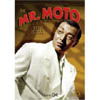 The Mr. Moto films overlapped with the Oland cycle. John P. Marquand introduced Moto in the novel No Hero (1935) and made him more central to four novels that followed. Again, Fox bought the rights and launched the film series with Thank You, Mr. Moto (1937). It starred Peter Lorre as the mysterious Japanese, and I think it’s fair to say that the role made him a Hollywood star. The series ran for eight installments, ending in 1939 with Mr. Moto Takes a Vacation.
The Mr. Moto films overlapped with the Oland cycle. John P. Marquand introduced Moto in the novel No Hero (1935) and made him more central to four novels that followed. Again, Fox bought the rights and launched the film series with Thank You, Mr. Moto (1937). It starred Peter Lorre as the mysterious Japanese, and I think it’s fair to say that the role made him a Hollywood star. The series ran for eight installments, ending in 1939 with Mr. Moto Takes a Vacation.
Each series echoed its mate. Tim claimed that in an early Chan, a character is reading a Moto story in the Saturday Evening Post, though I’ve never found that scene. When Charlie’s Number One Son turns up to help Moto in Mr. Moto’s Gamble (1938) it’s revealed that Charlie and Moto are old friends. There’s a more elegiac moment in Mr. Moto’s Last Warning (1939) when a theatre displays a poster for the Chan series—perhaps as well serving as an homage to the recently deceased Warner Oland. Despite Oland’s death, the Chan series continued until 1949, with Sidney Toler in the role, but with Lorre’s departure the Moto films ceased.
Having a Caucasian actor play an Asian protagonist was common at the time. Today, it seems condescending or worse, but we should recognize that the films featured Asian actors as well, often in significant roles. The most visible example is Keye Luke as Charlie’s highly Americanized son. Forever blurting out “Gosh, Pop!” Luke is a lively and likable presence.
Just as important, the portrayal of the detectives is remarkably free of racism. Charlie and Moto are clearly the quickest-witted characters, and both prove resourceful in all kinds of ways. Moto’s judo subdues thugs twice his size, and Charlie is up-to-date in the new technologies of detection.
The scripts go out of their way to show both men skilfully handling the prejudice they encounter. In Charlie Chan at the Opera (1936), a blatantly racist cop (William Demarest) who calls Charlie “Chop Suey” is mocked incessantly by everyone, most gently by Charlie. Moto excels at pretending to be the stereotypical Asian (“Ah, so!” “Suiting you?”). And both our protagonists are sympathetic to others who are in minorities. Charlie is notably unwilling to participate in guying black servants as the whites do, and Charlie Chan at the Circus (1936) shows his keen sympathy with the “freaks,” treating them with quiet courtesy. The Moto series presents a Japanese who doesn’t seem to share his country’s goal of ruling Asia. In Thank You, Mr. Moto, he enjoys a respectful friendship with a Chinese family of declining fortunes.
 The Chan series features straightforward detection. A murder is committed, and either Charlie is in the vicinity or the police ask for his help. A young and innocent couple is involved, adding pressure for Charlie to solve the case. Another murder is likely to take place, and a few attempts are made on Charlie’s life before he comes to the solution. In traditional fashion he tends to assemble all the suspects at the climax before exposing the guilty party.
The Chan series features straightforward detection. A murder is committed, and either Charlie is in the vicinity or the police ask for his help. A young and innocent couple is involved, adding pressure for Charlie to solve the case. Another murder is likely to take place, and a few attempts are made on Charlie’s life before he comes to the solution. In traditional fashion he tends to assemble all the suspects at the climax before exposing the guilty party.
 The Moto films aren’t as concerned with puzzles. Like the novels, they’re tales of international intrigue, involving smuggling, theft of archaeological treasures, and the like. There’s more violence and physical action, with shootouts and last-minute rescues. Moto Kentaro (his given name is visible only on his identity card) is a more shadowy presence than Charlie, often working under vague auspices. He’s either an agent of Interpol, a functionary of the Japanese government, or an exporter who takes up intrigue as a hobby. (1) In Mr. Moto’s Gamble, arguably the best of the series, he engages in old-fashioned detection involving murder during a boxing match. Unsurprisingly, the film was originally planned as a Chan vehicle, and it even includes Number One Son as Moto’s sidekick.
The Moto films aren’t as concerned with puzzles. Like the novels, they’re tales of international intrigue, involving smuggling, theft of archaeological treasures, and the like. There’s more violence and physical action, with shootouts and last-minute rescues. Moto Kentaro (his given name is visible only on his identity card) is a more shadowy presence than Charlie, often working under vague auspices. He’s either an agent of Interpol, a functionary of the Japanese government, or an exporter who takes up intrigue as a hobby. (1) In Mr. Moto’s Gamble, arguably the best of the series, he engages in old-fashioned detection involving murder during a boxing match. Unsurprisingly, the film was originally planned as a Chan vehicle, and it even includes Number One Son as Moto’s sidekick.
Looks and looking


We can learn a lot by studying the two main actors’ performance styles. The plump Oland plays Chan as stolid but not ponderous. He floats across a room and gravely circulates among suspects, giving the films their deliberate pacing. Oland’s drawn-out delivery and pauses were due, people say, to his acute alcoholism, but he never seems to be struggling to find his lines. Charlie is at pains to be unobtrusive, modest, and tactful; his characteristic gesture is a simple one, letting the fingertips of one hand grasp one finger of the other.
He is a loving father, doting on his many children (all in tow in Charlie Chan at the Circus). Although Number One Son may exasperate him, you would go far in films to find as warm a portrayal of a father’s affectionate efforts to curb an impulsive boy. See Charlie Chan at the Olympics (1937) for the casual byplay between Charlie and Lee, now an art major and a member of the swimming team. Lee’s bubbling energy gives Charlie’s imperturbability even greater gravitas.
The short and slim Lorre plays Moto as a suave man-about-Asia, hand thrust casually into his trouser pocket. Moto is an art connoisseur, a graduate of Stanford (class of ‘21), and a master of many languages. Lorre, so easily caricatured at the time and now, hit on a brilliant idea: He didn’t give Moto stereotyped tricks of pronunciation. Unlike Oland, he didn’t usually drop articles or compress syntax.(2) Lorre just played the part in his lightly accented English, as he would in The Maltese Falcon and Casablanca. He added a soft-spoken delivery, a modest smile, and a trick he may have picked up from Marlene Dietrich–ending his sentences with a slight upward inflection, turning every statement into a polite question.
Reaction shots of suspects are a convention of these movies, but after several cuts show us everybody looking shifty, the reverse shots of our heroes show us that they miss none of this byplay. (3) Charlie is alert, but he hides his penetrating view behind a bland courtesy. As Moto, Lorre presents a more aggressive intelligence. Peering through round spectacles, those bug eyes, panic-stricken in M, can now become pensive or bore into a suspect. Charlie needs the force of law, but Moto, who usually acts alone, is dangerous by himself, and Lorre’s horror-show pedigree serves him well in giving his hero’s stare a sinister edge.
Listening and looking


You can argue that Oland and Lorre, coming to their parts only a few years after sound had arrived, helped Hollywood develop a wider array of acting styles. We historians of Hollywood have rightly praised gabby comedies like Twentieth Century (1934) and It Happened One Night (1934) for finding a performance technique suited to sound films, particularly in the wake of technical improvements in acoustic recording. If movies had to talk, we think, they should really talk, fast and hard and heedlessly. In this church our Book of Revelations is His Girl Friday (1940).
Lorre and Oland, like Karloff and Lugosi, remind us of the virtues of being gentle, spacious, and deliberate. This isn’t a reversion to those hesitant, strangled mumblings of the earliest talkies. Rather, the movies’ plots surround our Asians with rapid-fire duels of cops and reporters, snapping out “Say!” and “Hiya, sister!” and “Watch it, wise guy!” and “Don’t be a sap!” Against clattering percussion Moto and Charlie deliver a melodic purr.
Some people still believe that in Citizen Kane Welles and Gregg Toland introduced American film to steep low angles, tight depth compositions, and noirish lighting. In The Classical Hollywood Cinema, I’ve argued that the Gothic, somewhat cartoonish look of Kane synthesized and amplified trends that were emerging during the 1930s. The Chan and Moto films are wonderful places to study these visual schemas.

 E
E
In Charlie Chan in Egypt (1935, above), cinematographer Charles G. Clarke (whom Kristin and I interviewed for the Hollywood book) offers flashy depth and silhouette effects, and nearly all the Chan films have moments of clever staging. Charlie Chan at the Opera, above, is particularly engrossing, with its huge set (recycled from the A-picture Café Metropole, 1937). The same film, incidentally, contains scenes of a fictitious opera, Carnival, composed by Oscar Levant. This was an ambitious gesture for a B film and looks forward to Bernard Herrman’s Salammbo sequences of Kane.
The Motos are even more remarkable. You want wild angles? Venetian-blind shadows? Telltale reflections in eyeglasses? Swishing bead curtains? Twisted expressionist décor? You’ve come to the right place.




Some late thirties Fox sets seem to have been stored in Caligari’s Cabinet. Watching these films, it becomes clear that Kane applied the moody technique of crime and horror films to ambitious drama. One bold setup in Mr. Moto’s Gamble looks like a dry run for a Toland big-foreground composition (done here, as often in Kane, through special-effects). I like this shot so much I used it in Figures Traced in Light.
Yet all this creativity took place within severe constaints. These were B pictures, running under seventy minutes and shot in a month or so. Three or four would be released each year. They shamelessly used stock footage, leftover sets, and the same players in different roles from film to film. (Watch for Ray Milland, Ward Bond, and others on the way up.) The boys in the Fox cutting room seem to have enforced a remarkable uniformity: most of the Chans in these DVD sets, regardless of director, contain between 600 and 660 shots, while the faster-paced Motos average between four and six seconds per shot. The actors created hurdles too. Oland sank even further into drinking while the high-strung Lorre was addicted to morphine and periodically retired to sanitariums to recover. Those were the days; rehab wasn’t yet a matter for infotainment.
The Fox DVD boxes are model releases. The prints are well-restored (better on the second sets than the first) and filled with astute, informative supplements. We get a lot of detail about production matters, including why Oland left Hollywood. There is welcome biographical background on master minds like Sol Wurtzel and Norman Foster. I still want to know more about James Tinling, though; his direction of Mr. Moto’s Gamble and Charlie Chan in Shanghai (1935) belies his reputation as a hack.
“The cinema is not dangerous,” Moto reassures the Siamese tribesmen about to be filmed in Mr. Moto Takes a Chance (1938). Immediately, the woman who’s being filmed dies. The adventure begins. Who can resist movies like these? They have kept me happy since my childhood, when I watched them on Sunday afternoon TV. They can keep your children, and you, happy too.
For some good reading, see John Tuska, The Detective in Hollywood (Doubleday, 1978); Charles Mitchell, A Guide to Charlie Chan Films (Greenwood, 1999); Howard M. Berlin, The Complete Mr. Moto Film Phile: A Casebook (Wildside, 2005); and Stephen Youngkin, The Lost One: A Life of Peter Lorre (University Press of Kentucky, 2005).
For more on Charlie, click here. Charles Mitchell has a nice wrapup on Kentaro here.
(1) The involvement of an innocent romantic couple was a convention of slick-magazine fiction of the day (both the Chan and Moto novels were serialized in the Saturday Evening Post), and it recurs throughout mainstream detective fiction of the 1930s. Most writers of the period wrestled with the problem of how to make the couple interesting. See Carter Dickson/ John Dickson Carr’s short story, “The House in Goblin Wood,” for a brilliant handling of the device.
(2) As many commentators have noted, Charlie doesn’t speak pidgin English; he seems to be mentally translating. Interestingly, the generation gap is apparent here too, since Number One Son speaks peppy and perfect American slang.
(3) One hyperclever moment in Mr. Moto’s Gamble gives us the usual rapid-fire array of single shots of discomfited suspects but neglects to show us the real culprit.
Movies still matter

Kristin here—
I don’t know whether I should be grateful or not when I read the film trade journals or major newspapers and run across columns bemoaning the decline of the cinema. On the one hand, these give me plenty of fodder for blogging. On the other, they promote a false impression that the movie industry and the art form in general are in far worse shape than they really are.
One recent case in point is Neil Gabler’s “The movie magic is gone,” from February 25, where he says that movies have lost their previous importance in American society and are less and less relevant to our lives.
Gabler makes some sweeping claims. Movie attendance is down because movies have lost the importance they once had in our culture. Our obsession with stars and celebrities has replaced our interest in the movies that create them. Niche marketing has replaced the old “communal appeal” of movies. The internet intensifies that division of audiences into tiny groups and fosters a growing narcissism among consumers of popular culture. Audiences have become less passive, creating their own movies for outlets like YouTube. In videogames, people’s avatars make them stars in their own right, and the narratives of games replace those of movies.
Films will survive, Gabler concludes, but they face “a challenge to the basic psychological satisfactions that the movies have traditionally provided. Where the movies once supplied plots, there are alternative plots everywhere.” This epochal challenge, he says, “may be a matter of metaphysics.”
All this is news to me, and I think I have been paying fairly close attention to what has been going on in the moviemaking sphere over the past ten years—the period over which Gabler claims all this has been happening. Evidence suggests that all of his points are invalid.
1. Gabler states that “the American film industry has been in a slow downward spiral.” Based on figures from Exhibitors Relations, a box-office tracking firm, attendance at theaters fell from 2005 (a particularly down year) to 2006. A Zogby survey found that 45% of Americans had decreased their movie-going over the past five years, especially including the key 18-24-year-old audience. “Foreign receipts have been down, too, and even DVD sales are plateauing.” Such a broad decline “suggests that something has fundamentally changed in our relationship to the movies.”
Turning to a March 6 Variety article by Ian Mohr, “Box office, admissions rise in 2006,” we read a very different account of recent trends. According to the Motion Picture Association of America, admissions rose, “with 1.45 billion tickets sold in 2006—ending a three-year downward trend.” Foreign markets improved as well, “where international box office set a record of $16.33 billion as it jumped 14% from the 2005 total.” Within the U.S., grosses rose 5.5% over 2005.
We should keep in mind that part of the perception of a recent decline comes from the fact that 2002 was a huge year for box-office totals, mainly stemming from the coincidence of releases of entries in what were then the four biggest franchises going: Spider-man, The Lord of the Rings, Harry Potter, and Star Wars. There was almost bound to be a decline after that. Such films make so much money that the fluctuations in annual box-office receipts in part reflect the number of mega-blockbusters that appear in a given year.
Looking at the longer terms, though, the biggest decline in U.S. movie-going was in the 1950s, as television and other competing leisure activities chipped away at audiences. Even so, the movies survived and from 1960 onward annual attendance hovered at just under a billion people. From 1992 on, a slow rise occurred, until by 1998 it reached roughly 1.5 billion and has hovered around that figure ever since, with a peak in 2002 at 1.63 billion. Variety’s figure of 1.45 billion for 2006 fits the pattern perfectly. In short, there has been no significant fall-off since the 1950s. (See the appendix in David’s The Way Hollywood Tells It for a year-by-year breakdown.) The article also states that industry observers expect 2007 to be especially high, given the Harry Potter, Spider-man, and Pirates of the Caribbean entries due out this year. About a year from now, expect pundits to be seeking reasons within the culture why movie-going is up. I suspect they will find that we are looking for escapism. Safe enough. When aren’t we?
Apart from theatrical attendance figures, let’s not forget that more people are watching the same movies on DVDs and on bootleg copies that don’t get into the official statistics.
2. Gabler claims that movies are no longer “the democratic art” that they were in the 20th Century. During that century, even faced with the introduction of TV, “the movies still managed to occupy the center of American life….A Pauline Kael review in the New Yorker could once ignite an intellectual firestorm … People don’t talk about movies the way they once did.”
Maybe the occasional Kael review created debate, as when she claimed that Last Tango in Paris was the “Rite of Spring” of the cinema. I think we all know by now that she was wrong. A lot of us even knew it at the time, and it’s no wonder that people argued with her. I doubt that attempts to refute her claims there or in other reviews reflected much about the health of the general population’s enthusiasm for movies.
More crucially, however, people do still talk about the movies, and lively debates go on. It’s just that now much of the discussion happens on the internet, on blogs and specialized movie sites, and in Yahoo! groups. (Who would have thought that David’s entry on Sátántango would be popular, and yet there turn out to be quite a few people out there passionately interested in Tarr’s film.)
Some would see the health of movie fandom on the internet as a sign that the cinema has become more democratic than ever. Now it’s not just casual water-cooler talk or a group of critics arguing among themselves. Anyone can get involved. The results range from vapid to insightful, but there’s an immense amount of discussion going on.
3. Interest in movies has eroded in part due to what Gabler has termed “knowingness.” By this he means the delight people take in knowing the latest gossip about celebrities. Movies have declined in importance because they exist now in part to feed tabloids and entertainment magazines.
“Knowingness” is basically a taste for infotainment. Infotainment had been around in a small way since before World War I in the form of fan magazines and gossip columns. It really took off beginning in the 1970s, with the rise of cable and the growth of big media companies that could promote their products—like movies—across multiple platforms. (I trace the rise of infotainment in Chapter 4 of The Frodo Franchise.) It’s not clear why one should assume that a greater consumption of infotainment leads to less interest in going to movies.
People in the film industry seem to assume the opposite. Studio publicity departments and stars’ personal publicity managers feed the gossip outlets, in part to control what sorts of information get out but mainly because those outlets provide great swathes of free publicity. With the rise of new media, there are more infotainment outlets appearing all the time. Naturally this trend is obvious even to those of us who don’t care about Britney’s latest escapade. But I doubt that watching Britney coverage actually makes people less inclined to go to, say, The Devil Wears Prada, one of the mid-range surprise successes that helped boost 2006’s box-office figures.
4. Movies have lost their “communal appeal” in part because the public has splintered into smaller groups, and the industry targets more specialized niche markets. According to Gabler, “the conservative impulse of our politics that has promoted the individual rather than the community has helped undermine movies’ communitarian appeal.”
Let’s put aside the idea that conservative politics erode the desire for community. The extreme right wing has certainly put enough stress on community and has banded together all too effectively to promote their own mutual interests lately. But is the industry truly marketing primarily to niche audiences?
Of course there are genre films. There always have been. Some appeal to limited audiences, as with the teen-oriented slasher movie. Yet despite the continued production of low-budget horror films, comedies, romances, and so on, Hollywood makes movies aimed at the “family” market because so many moviegoers fit into that category. Most of the successful blockbusters of recent years have consistently been rated PG or PG-13. According to Variety, 85% of the top 20 films of 2006 carried these ratings. Pirates of the Caribbean, Spider-man, Harry Potter—these are not niche pictures, though distributors typically devise a series of marketing strategies for each film, with some appealing to teen-age girls, others to older couples, and so on.
(An important essay by Peter Krämer discusses blockbusters with broad appeal: “Would you take your child to see this film? The cultural and social work of the family-adventure movie,” in Steve Neale and Murray Smith’s anthology, Contemporary Hollywood Cinema, published by Routledge in 1998.)
The result is that, despite the fact that niche-oriented films appear and draw in a limited demographic, there are certain “event” pictures every year that nearly everyone who goes to movies at all will see—more so than was probably the case in the classic studio era. Those films saturate our culture, however briefly, and surely they “enter the nation’s conversation,” as Gabler claims “older” films like The Godfather, Titanic, and The Lord of the Rings did. By the way, the last installment of The Lord of the Rings came out only a little over three years ago. Surely the vast cultural upheaval that the author posits can’t have happened that quickly.
5. The internet exacerbates this niche effect by dividing users into tiny groups and creates a “narcissism” that “undermines the movies.”
See number 2 above. I don’t know why participating in small group discussions on the internet should breed narcissism any more than would a bunch of people standing around an office talking about the same thing. In fact, there are thousands of people on the internet spending a lot of their own time and effort, many of them not getting paid for it, providing information and striving to interest others in the movies they admire.
The internet allows likeminded people to find each other with blinding speed. Often fans will stress the fact that what they form are communities. They delight in knowing that many share their taste and want to interact with them. Some of these people no doubt have big egos and are showing off to whomever will pay attention. Narcissism, however, implies a solitary self-absorption that seems rare in online communities.
A great many of these communities form around interest in movies. In this way, the internet has made movies more important in these people’s lives, not less.
6. Audiences have become active, creating their own entertainment for outlets like YouTube, and are hence less interested in passive movie viewing. These are situations “in which the user is effectively made into a star and in which content is democratized.”
No doubt more people are writing, composing, filming, and otherwise being creative because of the internet. Some of this creativity and the consumption of it by internet users takes up time they could be using watching movies.
Yet anyone who visits YouTube knows that a huge number of the clips and shorts posted there are movie scenes, trailers, music videos based on movie scenes, little films re-edited out of shots taken from existing movies, and so on. In some cases the makers of these films have pored over the original and lovingly re-crafted it in very clever ways. A lot of the creativity Gabler notes actually is inspired by movies. Some people post their films on YouTube because they are aspiring movie-makers hoping to get noticed. The movie industry as a whole is not at odds with YouTube and other sites of fan activity, despite the occasional removal of items deemed to constitute piracy.
7. New media allow these active, narcissistic spectators to star in their own “alternative lives.” “Who needs Brad Pitt if you can be your own hero on a video game, make your own video on YouTube or feature yourself on Facebook?”
In discussing videogames, Gabler perpetuates the myth that “video games generate more income than movies.” This is far from being true, and hence his claim that videogames are superseding movies is shaky. (I debunk this myth in Chapter 8 of The Frodo Franchise.)
Even the spread of videogames does not necessarily mean that fans are deserting movies. On the contrary, there is evidence that people who consume new media also consume the old medium of cinema. Mohr’s Variety article reports on a recent study by Nielsen Entertainment/NRG: “Somewhat surprisingly, the same study revealed that the more home entertainment technology an American owns, the higher his rate of theater attendance outside the home. People with households containing four or more high-tech components or entertainment delivery systems—from DVD players to Netflix subscriptions, digital cable, videogame systems or high-def TV—see an average of three more films per year in theaters than people with less technology available in their homes.”
Apart from the shaky factual basis of the column, what does the end-of-cinema genre tell us about how trends get interpreted by commentators?
As I pointed out in my March 9 entry, some commentators explain perceived trends in film by generalizing about the content of the movies themselves. “As soon as some trend or apparent trend is spotted, the commentator turns to the content of the films to explain the change. If foreign or indie films dominate the awards season, it must be because blockbusters have finally outworn their welcome. If foreign or indie films decline, it must be because audiences want to retreat from reality into fantasy. It’s an easy way to generate copy that sounds like it’s saying something and will be easily comprehensible to the general reader.”
Gabler is arguing for something different—something that, if it were true would be more depressing for those who love movies. He’s not positing that movies have failed to cater to the national psyche. He’s claiming that other forces, largely involving new media, have changed that national psyche in a way which moviemakers could never really cope with. Cinema as an art form cannot provide what these other media can, and spectators caught up in the options those media offer will never go back to loving movies, no matter what stories or stars Hollywood comes up with. By his lights, the movies are apparently doomed to a long, irreversible decline.
Hollywood has what I think is a more sensible view of new media. Games, cell phones, websites, and all the platforms to come are ways of selling variants of the same material. Film plots are valuable not just as the basis for movies but because they are intellectual property that can be sold on DVD, pay-per-view, and soon, over the internet. They can be adapted into video games, music videos, and even old media products like graphic novels and board games.
Not only Hollywood but the new media industries have already analyzed the changing situation and come up with new approaches to dealing it. Check out IBM’s new Navigating the media divide: Innovating and enabling new business models. Those models include “Walled communities,” “Traditional media,” “New platform aggregation,” and “Content hyper-syndication,” which, the authors predict, “will likely coexist for the mid term.”
In other words, traditional media like the cinema aren’t dying out. No art form that has been devised across the history of humanity has disappeared. Movies didn’t kill theater, and TV didn’t kill movies. It’s highly significant that the main components of new media—computers, gaming consoles, and the internet—have all added features that allow us to watch movies on them.
The big movies still get more press coverage than the big videogames partly because they usually are the source of the whole string of products. If a movie doesn’t sell well, it’s likely that its videogame and its DVD and all its other ancillaries won’t either. That is a key word, for many of the new media that Gabler mentions produce the ancillaries revolving around a movie. So far, very few movies are themselves ancillary to anything generated with new media. If you doubt that, check out Box Office Mojo’s chart of films based on videogames, which contains all of 22 entries made since 1989.
One final point. Film festivals are springing up like weeds around the world. Enthusiasts travel long distances to attend them. That’s devotion to movies. From last year’s Wisconsin Film Festival, add 26,000 tickets sold to that 1.5 billion attendance figure.
Movies still matter enormously to many people. New media have given them new ways to reach us, and us new ways to explore why they matter.
World rejects Hollywood blockbusters!?

(T)Raumschiff Surprise–Period 1
Kristin here—
I’ve just returned from two weeks in Egypt, and on the ten-hour flight from Cairo to New York, I had plenty of time to absorb the contents of the February 24-25 edition of the International Herald Tribune. One of its articles, “Hollywood rides off into the setting sun,” proclaimed the imminent decline of Hollywood.
The co-authors of this article are Nathan Gardels, editor of NPQ and Global Viewpoint, and Michael Medavoy, CEO of Phoenix Pictures and producer of, among many others, Miss Potter. These two are, according to the biographical blurb accompanying the article, writing “a book about the role of Hollywood in the rise and fall of America’s image in the world.”
The Tribune piece is a slightly abridged version of an essay that appeared on The Huffington Post on February 21, 2007 under the title “Hearts and Minds vs. Shock and Awe at the Oscars.” The subject is not really the Oscars, though, but the supposed decline in interest in American blockbusters, both in the USA and abroad. The authors make a series of claims to suggest that Hollywood is about to lose its “century-long” status as the center of world filmmaking. (Actually American films didn’t gain dominance on world markets until early 1915, but that’s a quibble in the face of the other shaky claims made here.)
1. Foreign films are getting all the awards and prestige this year. “Films by foreigners such as ‘Babel,’ ‘The Queen’ and ‘Volver’ that make little at the box office are winning the top awards while the big Hollywood blockbusters, which make all the money, much of it abroad, are being virtually ignored.” Gardels and Medavoy point out that even veteran director Clint Eastwood figured prominently in the nominations by making a Japanese-language film.
Several objections can be made to this. Technically The Queen is foreign, but it’s not foreign-language. Besides, British films have figured in the Oscars since Charles Laughton won as Best Actor by playing a king in The Private Life of Henry VIII back in 1933. Let’s factor out British films, shall we?
Of course Gardels and Medavoy couldn’t know this when they wrote the piece, but none of those “foreign” films won. An American genre film did. A much-respected Hollywood director finally got an Oscar as best director. He remade a Hong Kong film, secure in the knowledge that most Americans won’t watch a foreign-language import like Infernal Affairs.
Plenty of non-foreign films get awards and prestige. There have been years—like 2005—when most of the best-picture nominees were English-language art-house films like Crash and Brokeback Mountain. If The Departed hadn’t been crowned Best Picture this year, one other good contender would have been Little Miss Sunshine. Think back over how many indies have won Best Picture in the last decade or so. The English Patient and Chicago (both Miramax) come to mind. (Gardels and Medavoy never make mention of independent American films, since their argument presumes that non-formulaic films come only from abroad.)
2. Foreign films show “the world in transition as we are living it.” That is, they reflect the real world and hence are more admired and more admirable. In contrast most “American filmmakers too often grind out formulaic, shock and awe blockbusters.”
Again, there are plenty of American films that don’t fall into the “blockbuster” category. Directors like Quentin Tarantino, David Lynch, Tim Burton, the Coen Brothers, and Christopher Nolan are admired internationally for their unconventional films. Conversely, most films made in foreign countries are no less formulaic than ours. Other countries’ popular comedies, crime films, and horror pics are almost never imported into the USA.
3. Hollywood’s blockbusters “may be winning the battle of Monday morning grosses, but are losing the war for hearts and minds.”
Whose hearts and minds are the authors talking about? Doesn’t a film win hearts and minds by drawing people into theaters? So if blockbusters are popular, aren’t they, at least in some sense, winning hearts and minds? Obtaining Oscar nominations means these films have won the Academy members’ hearts and minds, or in the case of the many critics’ awards, the hearts and minds of journalists.
4. “Audience trends for American blockbusters are beginning to show a decline as well, both at home and abroad.” According to Gardels and Medavoy, the fact that films now gross more abroad than at home suggests that the American public is tired of these big pictures.
This claim is self-contradictory. If blockbusters make more in foreign countries than in the USA, then there would not appear to be evidence for a decline of audiences for such film abroad—unless, of course, there has been an overall decline in box-office income worldwide. That’s not true. In the past four years, two films, The Lord of the Rings: The Return of the King and Pirates of the Caribbean: Dead Man’s Chest, have made over a billion dollars each internationally. They now stand at, respectively, second and third on the all-time box-office chart (in unadjusted dollars).
Even if we assume that just Americans are getting tired of their own formulaic films, the authors’ argument doesn’t work. They lump Titanic, Jurassic Park, and Star Wars Episode I—The Phantom Menace together with Mission Impossible III and Poseidon as having earned large percentages of their worldwide box-office income outside the USA. Clearly, though, the cases are not comparable. The first three were enormously successful in the USA as well as abroad. Similarly, The Lord of the Rings and the Harry Potter series have brought in around two-thirds of their income outside the US, but one would hardly claim that Americans didn’t like them. The Da Vinci Code brought in over 71% of its total gross abroad but in 2006 it was also the fifth highest-grossing film in the American market.
The authors have chosen two films, Mission: Impossible III and Poseidon, to support their case. Yet in general big action films that perform poorly or even flop in the American market tend to do better in foreign countries, especially if they have auteur directors and big stars. Other examples of recent years have been Oliver Stone’s Alexander and Ridley Scott’s Kingdom of Heaven. Indeed, the importance of stars in selling Hollywood films can hardly be overemphasized. For instance, Tom Cruise is enormously popular in Japan, where Mission: Impossible III grossed $44 million of its $398 million worldwide income. There are few comparable international stars working in foreign-language films.
The rising proportion of receipts abroad results largely from reasons other than any putative decline in the popularity of American cinema. For one thing, rising prosperity in developing countries has made movie-going more affordable, and hence there are more movie-goers. The fall of Communism and the new profit orientation in China have opened large new markets for American films. Most crucially, a huge boom in the construction of multiplexes in South America, Europe, and much of Asia during the 1990s and early 2000s raised the number and cost of tickets sold outside the US. It isn’t the American market that has shrunk. It’s the foreign market that has expanded.
Moreover, comparisons between the total box-office income of films within the American market and in foreign ones are often misleading due to currency fluctuations. The recent weakness of the American dollar against many other currencies has made it considerably easier for those in other countries to see Hollywood’s products. Theatrical income does not necessarily reflect the number of tickets sold or the price of those tickets in local currencies. Hence raw statistics may not accurately indicate the actual popularity of any given title.
5. Countries increasingly are favoring their domestically produced films. “Even long-time American cultural colonies like Japan and Germany are beginning to turn to the home screen.”
This isn’t a new and consistent trend. Some countries have been doing quite well in their own markets for years, partly due to government subsidies for the film industry. France is one such market. Germany had a good year in 2006, but 2005 was a bad one. Many such successes are cyclical. Recently films made in Denmark and South Korea have gained remarkable portions of their domestic film markets, and if they decline, other countries will take their places for a period of relative prosperity.
We should also keep in mind that some countries have exhibition quotas for domestic films. South Korea, which provides government subsidies for filmmaking, in recent years has also required that 40% of exhibition days be given over to domestic films. That quota was halved to 20% last July 1, with filmmakers fearing a surge in competition from Hollywood. In fact September saw the Korean share of the domestic market rise to 83%, but this was largely due to two big hits: The Host and Tazza: The High Rollers. Such success can be ephemeral, however, and the government has recently imposed a tax on movie tickets designed to generate a fund for supporting local filmmaking. Variety’s Asian branch has recently predicted a slump in South Korea for 2007.
Moreover, German or Danish films doing well in their own markets doesn’t mean that they’re beating Hollywood at its own game. American films are truly international products, and blockbusters play in most foreign markets. A non-English-language market like Denmark may produce films that gain considerable screen time at home, but they do not circulate outside the country on nearly the scale of the American product.
Take, for example, the most successful German filmmaker of recent years, actor-director Michael “Bully” Herbig (on the left in the frame above). Within Germany his wildly popular comedy Der Schuh des Manitu (2001) sold almost as many tickets as Harry Potter and the Sorcerer’s Stone, and his over-the-top gay Star Trek parody (T)Raumschiff Surprise—Period 1 (2004) grossed more than twice as much as Spider-Man 2. Most people outside of Germany have never heard of him or his films. There are comic stars like him in many countries. In general popular local comedies—many of them as formulaic as any Hollywood product—don’t travel well.
[Added March 9:
More evidence for my claims that successful foreign-language films often don’t circulate widely outside their countries of origin comes in the February 23 issue of Screen International. In an essay entitled “Calling on the Neighbours,” Michael Gubbins discusses new funding that the European Union is putting into film specifically to promote the wider distribution of films. “The performance of European films outside their home markets remains one of the thorniest issues for the EU’s policy-makers,” Gubbins writes. “Last year’s box-office recovery in many European territories was largely built on the success of local films in local markets and a number of Hollywood blockbusters.”
In 1995, production within Europe totaled 600 films, and it rose to 800 films in 2005. Yet “that rise in production has not been matched by admissions, which have fluctuated strongly over the late five years. There has been little to suggest that increased production has helped European films travel beyond their borders.”]
6. The competition from increasingly successful national cinemas “suggests that we may be seeing the beginning of the end of the century-long honeymoon of Hollywood, at least in its American incarnation, with the world.”
I don’t know what the authors mean by “Hollywood, at least in its American incarnation.” Has Hollywood existed elsewhere?
Actually, I think that Hollywood may well be in decline, at least as a center for filmmaking in the sense of planning, shooting, and post-producing a movie. That isn’t happening, however, for the reasons that Gardels and Medavoy offer in their article.
One factor is the globalization of film financing. Many films these days are co-productions between companies in different countries. It’s sometimes hard to determine the nationality of a film, given its several participants. The English language, however, remains central to most internationally successful films, and that is unlikely to change any time soon. The most popular stars still tend to come from English-speaking countries or to be able to speak English well, as actors like Juliette Binoche and Penélope Cruz can.
Another factor in globalization is the increasing tendency to make American-based productions partly or entirely abroad. Off-shore production has actually been fairly common since World War II. In the post-war austerity, many countries restricted how much currency could be taken out, and Hollywood firms spent their income by covering the production costs of films made abroad.
Even with the easing of such restrictions, the trend continued. The most traditional modern reason is simply cost-cutting through inexpensive labor and other expenses—advantages that have long been found in Eastern European countries. More recently countries have seen the economic advantages of an environmentally friendly enterprise like filmmaking. More and more of them have put various tax and other financial benefits into place in an effort to be competitive in the search for off-shore productions. For example, the February 2-8, 2007 issue of Screen International contains an ad placed by the Puerto Rico Film Commission (p. 40) declaring that “Puerto Rico is Ready for Action” and offering a remarkable 40% rebate on local expenditures. It also touts the country’s “experienced bilingual local crews” and its “infrastructure.”
One important cause for the off-shore trend that I deal with in The Frodo Franchise is the fact that technological change now offers the possibility of making films entirely abroad, from planning to post-production. Ten years ago it would have been almost unthinkable to have sophisticated special effects created by anyone other than the big American specialty firms like Rhythm and Hues or Industrial Light & Magic. Now world-class digital effects houses are springing up around the globe, and one of the top firms, Weta Digital, is located in a small suburb of Wellington, New Zealand. When a huge, complex production like The Lord of the Rings can be almost entirely made in a country with a miniscule production history, there is far less reason for American producers to confine any phase of their projects to the traditional capital of filmmaking.
There may indeed be an ongoing decline in Hollywood’s importance in world cinema, but it isn’t happening quickly. For one thing, there is no reason to think that US firms will soon cease to be the main sources of financing and organization of filmmaking. Even if Hollywood stopped making films and just distributed the most popular ones from abroad and from American indies, it would remain the most important locale for the film industry. As anyone who studies or works in that industry knows, distribution is the financial core of the whole process.
Finally, we shouldn’t forget that since early in the history of the cinema the USA has been far and away the largest exhibition market for films. No other single country can match it, and Europe’s attempts to create a united multi-national market to rival it have so far made slow progress. With such a firm basis, the Hollywood industry can simply afford to spend more on its films than can firms in most countries. Expensive production values help create movies that have international appeal, in part precisely because they are blockbusters of a type that are rarely made anywhere else.
In the international cinema, “shock and awe” and “hearts and minds” aren’t always as far apart as we might think.
Gardels and Medavoy’s analysis of Hollywood vs. foreign films falls into a common pattern within journalistic writing on entertainment. As soon as some trend or apparent trend is spotted, the commentator turns to the content of the films to explain the change. If foreign or indie films dominate the awards season, it must be because blockbusters have finally outworn their welcome. If foreign or indie films decline, it must be because audiences want to retreat from reality into fantasy. It’s an easy way to generate copy that sounds like it’s saying something and will be easily comprehensible to the general reader.
Such explanations depend on considerable generalizations that are usually made without taking into account the context of industry circumstances. Fluctuations like currency rates, tax loopholes, genre cycles, quotas, labor-union agreements, and similar factors interact in complex ways. All these are really difficult to keep track of and analyze, and most writers don’t bother, even though that would seem to be part of their job.
Almost inevitably commentators also fail to note that films typically take a very long time to get from conception to screen. Most releases of today actually reflect trends that were happening a few years ago. The world film industry is just too cumbersome to turn on a dime, or even on a few billion dollars.




